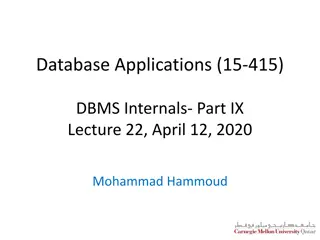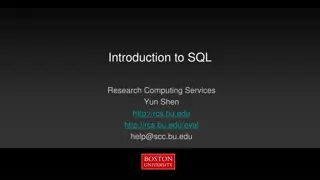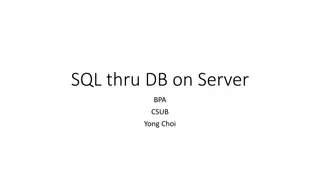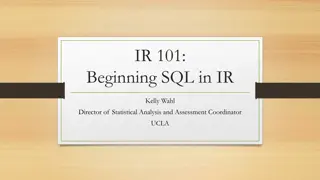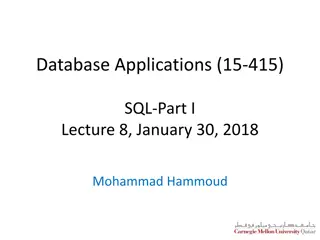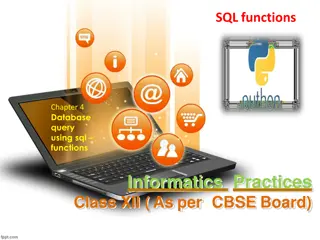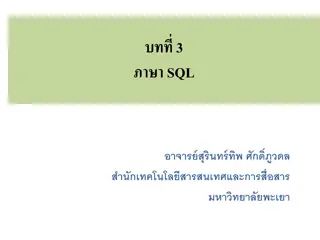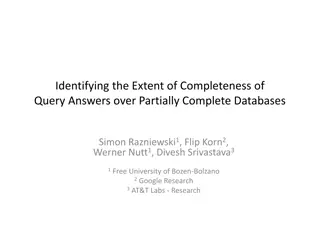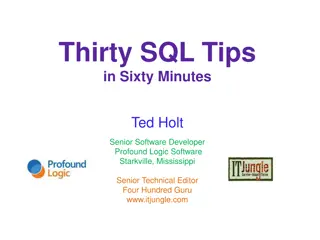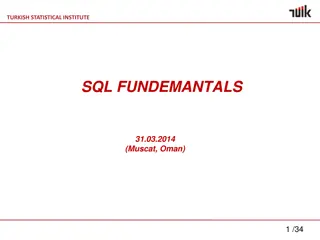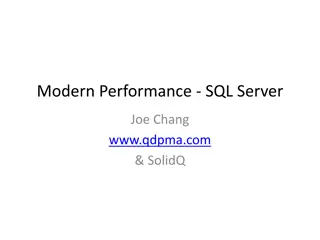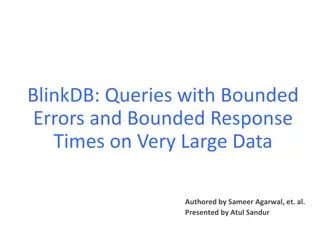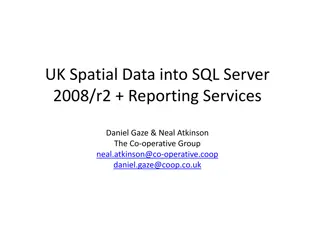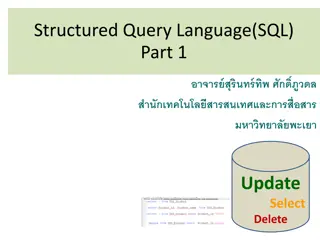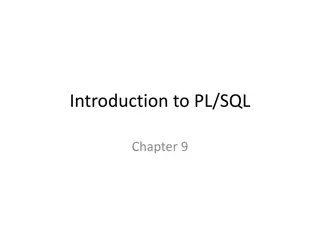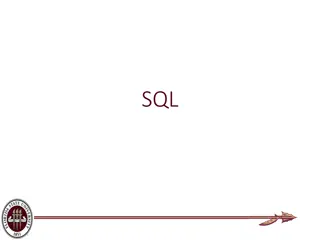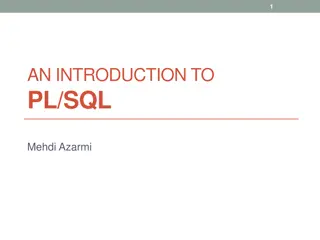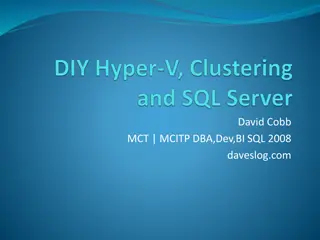SQL Query Language Basics
This content introduces the SQL query language, discussing its importance in modern data manipulation. It covers basic concepts of relational databases, contrasts with key-value stores, and highlights the scale differences between them. The history of databases, key-value stores, and the impact of the cloud on data management are also explored.
Download Presentation

Please find below an Image/Link to download the presentation.
The content on the website is provided AS IS for your information and personal use only. It may not be sold, licensed, or shared on other websites without obtaining consent from the author.If you encounter any issues during the download, it is possible that the publisher has removed the file from their server.
You are allowed to download the files provided on this website for personal or commercial use, subject to the condition that they are used lawfully. All files are the property of their respective owners.
The content on the website is provided AS IS for your information and personal use only. It may not be sold, licensed, or shared on other websites without obtaining consent from the author.
E N D
Presentation Transcript
CS5412: LECTURE 18 THE SQL QUERY LANGUAGE Ken Birman Fall, 2022 HTTP://WWW.CS.CORNELL.EDU/COURSES/CS5412/2022FA 1
SQL INTRODUCTION Standard language for querying and manipulating data Structured Query Language Many of today s slides were shared by the instructors of CSE544 at U. Washington HTTP://WWW.CS.CORNELL.EDU/COURSES/CS5412/2022FA 2
BASIC CONCEPTS A relational database is a set of tables ( relations ) with a layout ( schema ) that, in modern cloud settings, could be huge many columns ( attributes ) Each relation holds rows ( tuples ). In a big-data setting, there could be billions of rows and thousands of attributes. Some fields might hold nulls. Conceptually, a database is not sharded the model is expressed as if there was a single and complete database shared and seen by all users. HTTP://WWW.CS.CORNELL.EDU/COURSES/CS5412/2022FA 3
RELATIONAL DATABASE? OR KEY-VALUE STORE? On a slide they look kind of similar . . . . Key-value store Relational Databases HTTP://WWW.CS.CORNELL.EDU/COURSES/CS5412/2022FA 4
BUT SLIDES DONT CONVEY SCALE WELL The key-value store could be running on 2500 servers, split into 1250 shards that are each holding a huge amount of data in memory. The database system would probably run on just a few servers, maybe 3 to 5 per database (that illustration showed a few databases playing distinct roles). They could be interacting with vast amounts of storage, far more data than can be held in memory even at key-value scale , but the database itself probably doesn t run on a huge number of servers. HTTP://WWW.CS.CORNELL.EDU/COURSES/CS5412/2022FA 5
. . . RELATIONAL DATABASE? OR KEY-VALUE STORE? Key-value store Relational Databases A relational database system has a set of very sophisticated servers that host structured data ( relations ), plan and execute SQL queries. Provides what are called the ACID guarantees (A for atomicity). Often use locking for concurrency control Runs a two-phase commit protocol at the end of any updates A key-value store is simpler, only offers put/get/watch with O(1) performance. No locking or transactions, except perhaps one-shot atomic actions HTTP://WWW.CS.CORNELL.EDU/COURSES/CS5412/2022FA 6
A VERY BRIEF HISTORY OF THE AREA Databases were the dominant form of data management and computing from the 1980 s until around 2000. But the cloud took big data to a totally different scale, larger by 10,000x and at the same time, with a very different pattern of work This led to emergence of key-value stores and their NoSQL model HTTP://WWW.CS.CORNELL.EDU/COURSES/CS5412/2022FA 7
GENUINE DATABASES HAVE TWO HUGE ADVANTAGES: SIMPLE MODEL, ACID GUARANTEES Very natural to think in terms of tables (relations), transformations from table to table. SQL has simple ways to express connections between tabular data sets and to perform sophisticated data transformations. Users (mostly) don t worry about efficiency. The server executes requests efficiently, figures out which fast index structures to build, etc. But sometimes, a little help from a well-informed user pays off in big ways No complex technology ever is completely foolproof and self-managed HTTP://WWW.CS.CORNELL.EDU/COURSES/CS5412/2022FA 8
GENUINE DATABASES HAVE TWO HUGE ADVANTAGES: SIMPLE MODEL, ACID GUARANTEES SQL queries are executed as if the query was running in an idle system. ACID stands for atomic, consistent, isolated, durable. ACID properties: SQL operations are atomic (either executed completely, or any partial updates roll back), durable(database won t forget things) and the database server is able to stay busy (high level of concurrency while maintain these properties). HTTP://WWW.CS.CORNELL.EDU/COURSES/CS5412/2022FA 9
MONOLITHIC DATABASES RUNNING ON PARALLEL SERVERS DON T HANDLE BIG DATA VERY WELL We learned about Jim Gray s study early in the course. He looked at one big database somehow replicated across N servers. This was standard in the 1990 s. He explained that a drastic slowdown occurs: Overheads rise as O(N3 T5) The issue is that with an uncontrolled mix of transactions, locking conflicts (which sometimes trigger aborts/rollback) force the database to work harder and harder to do the same tasks. Leads to sharding HTTP://WWW.CS.CORNELL.EDU/COURSES/CS5412/2022FA 10
REMINDER: SHARDING A DATABASE Splits the big database into multiple independent databases. Queries can run on any one database, but never span across a set of them In this sharded model, we do get scalability. But we ve lost the ability to think of our data as if it lived in one big pool. Today, key-value sharding is mostly used with DHTs. Databases are still mostly monolithic, not sharded, but we use them very carefully! HTTP://WWW.CS.CORNELL.EDU/COURSES/CS5412/2022FA 11
YET DATABASES ARENT GONE!!! Relational Databases We do need to shield them from excessive load, to avoid collapse. Often we filter all the reads and only send them the updates. And we host them deep in the cloud, with layers of functions and -services to absorb as much work as possible But at the end of the pipeline, you still find massive enterprise databases in any major system. They continue to be one of the most important cloud components, even if key-value DHTs handle large categories of work! HTTP://WWW.CS.CORNELL.EDU/COURSES/CS5412/2022FA 12
SQL LANGUAGE Used to access or update relational (tabular data) In modern settings, the tables can be huge. Database will automatically fragment the data and parallelize the queries and updates for speed You can think of the database as a compiler: it translates your SQL code into a plan, then executes that plan for you. Like Python, but the data you care about lives in the database, and the program runs on it. HTTP://WWW.CS.CORNELL.EDU/COURSES/CS5412/2022FA 13
Relation name Attribute name EXAMPLE: A RELATION Product PName Price Category Manufacturer Gizmo $19.99 Gadgets GizmoWorks Powergizmo $29.99 Gadgets GizmoWorks SingleTouch $149.99 Photography Canon Tuple MultiTouch $203.99 Household Hitachi HTTP://WWW.CS.CORNELL.EDU/COURSES/CS5412/2022FA 14
NULLS IN SQL Whenever we don t have a value, we can put a NULL Can mean many things: Value does not exists Value exists but is unknown Value not applicable Etc. The schema specifies for each attribute if can be null (nullable attribute) or not How does SQL cope with tables that have NULLs ? HTTP://WWW.CS.CORNELL.EDU/COURSES/CS5412/2022FA 15
NULL VALUES If x= NULL then 4*(3-x)/7 is still NULL If x= NULL then x= Joe is UNKNOWN In SQL there are three truth values: FALSE = 0 UNKNOWN TRUE = 1 HTTP://WWW.CS.CORNELL.EDU/COURSES/CS5412/2022FA 16
SQL QUERY Basic form: (plus many many more bells and whistles) SELECT <attributes> FROM <one or more relations> WHERE <conditions> HTTP://WWW.CS.CORNELL.EDU/COURSES/CS5412/2022FA 17
SIMPLE SQL QUERY PName Price Category Manufacturer Product Gizmo $19.99 Gadgets GizmoWorks Powergizmo $29.99 Gadgets GizmoWorks SingleTouch $149.99 Photography Canon MultiTouch $203.99 Household Hitachi SELECT * FROM Product WHERE category= Gadgets PName Price Category Manufacturer Gizmo $19.99 Gadgets GizmoWorks Powergizmo $29.99 Gadgets GizmoWorks selection HTTP://WWW.CS.CORNELL.EDU/COURSES/CS5412/2022FA 18
SIMPLE SQL QUERY PName Price Category Manufacturer Product Gizmo $19.99 Gadgets GizmoWorks Powergizmo $29.99 Gadgets GizmoWorks SingleTouch $149.99 Photography Canon MultiTouch $203.99 Household Hitachi SELECT PName, Price, Manufacturer FROM Product WHERE Price > 100 PName Price Manufacturer selection and projection SingleTouch $149.99 Canon MultiTouch $203.99 Hitachi HTTP://WWW.CS.CORNELL.EDU/COURSES/CS5412/2022FA 19
NOTATION Input Schema. Here the designer indicates that Pname should be used as a unique key for each tuple Product(PName, Price, Category, Manfacturer) SELECT PName, Price, Manufacturer FROM Product WHERE Price > 100 Answer(PName, Price, Manfacturer) Output Schema. We could have named the output but here it was left anonymous HTTP://WWW.CS.CORNELL.EDU/COURSES/CS5412/2022FA 20
MANY OPTIONS FOR WHERE THE ANSWER LIVES You can just type the query, and it will print the answer You can tell the database to save the result as a new relation, with a new name. You just write newname = query. You can ask the database to remember the query and recompute the result as needed. This is called a dynamically materialized view... Like a virtual relation that is auto-updated when underlying data changes. HTTP://WWW.CS.CORNELL.EDU/COURSES/CS5412/2022FA 21
DISTINCT: A KEYWORD USED FOR ELIMINATING DUPLICATES Category SELECT DISTINCT category FROM Product Gadgets Photography Household Compare to: Category Gadgets SELECT category FROM Product Gadgets Photography Household HTTP://WWW.CS.CORNELL.EDU/COURSES/CS5412/2022FA 22
ORDERING THE RESULTS SELECT pname, price, manufacturer FROM Product WHERE category= gizmo AND price > 50 ORDER BY price, pname Ties are broken by the second attribute on the ORDER BY list, etc. Ordering is ascending, unless you specify the DESC keyword. HTTP://WWW.CS.CORNELL.EDU/COURSES/CS5412/2022FA 23
PName Price Category Manufacturer Gizmo $19.99 Gadgets GizmoWorks Powergizmo $29.99 Gadgets GizmoWorks SingleTouch $149.99 Photography Canon MultiTouch $203.99 Household Hitachi SELECT DISTINCT Category FROM Product ORDER BY Category ? ? ? HTTP://WWW.CS.CORNELL.EDU/COURSES/CS5412/2022FA SELECT Category FROM Product ORDER BY PName SELECT DISTINCT Category FROM Product ORDER BY PName 24
PName Price Category Manufacturer Gizmo $19.99 Gadgets GizmoWorks Powergizmo $29.99 Gadgets GizmoWorks SingleTouch $149.99 Photography Canon MultiTouch $203.99 Household Hitachi SELECT DISTINCT Category FROM Product ORDER BY Category Category Gadgets Household Photography Category Gadgets SELECT Category FROM Product ORDER BY PName Household Gadgets Photography Category Gadgets SELECT DISTINCT Category FROM Product ORDER BY PName Household Photography HTTP://WWW.CS.CORNELL.EDU/COURSES/CS5412/2022FA 25
KEYS AND FOREIGN KEYS Company CName StockPrice Country GizmoWorks 25 USA Key Canon 65 Japan Hitachi 15 Japan Product Foreign key: A key from CName in Company shows up in Product with a different name PName Gizmo Powergizmo SingleTouch MultiTouch Price $19.99 $29.99 $149.99 $203.99 Category Gadgets Gadgets Photography Household Manufacturer GizmoWorks GizmoWorks Canon Hitachi HTTP://WWW.CS.CORNELL.EDU/COURSES/CS5412/2022FA 26
JOINS ARISE WHEN WE WRITE QUERIES THAT OPERATE ON TWO OR MORE RELATIONS Product (pname, price, category, manufacturer) Company (cname, stockPrice, country) Join between Product and Company Find all products under $200 manufactured in Japan; return their names and prices. SELECT PName, Price FROM Product, Company WHERE Manufacturer=CName AND Country= Japan AND Price < 200 HTTP://WWW.CS.CORNELL.EDU/COURSES/CS5412/2022FA 27
JOINS Product Company PName Price Category Manufacturer Cname StockPrice Country Gizmo $19.99 Gadgets GizmoWorks GizmoWorks 25 USA Powergizmo $29.99 Gadgets GizmoWorks Canon 65 Japan SingleTouch $149.99 Photography Canon Hitachi 15 Japan MultiTouch $203.99 Household Hitachi SELECT PName, Price FROM Product, Company WHERE Manufacturer=CName AND Country= Japan AND Price < 200 PName Price SingleTouch $149.99 HTTP://WWW.CS.CORNELL.EDU/COURSES/CS5412/2022FA 28
NULL VALUES C1 AND C2 = min(C1, C2) C1 OR C2 = max(C1, C2) NOT C1 = 1 C1 E.g. age=20 heigth=NULL weight=200 SELECT * FROM Person WHERE (age < 25) AND (height > 6 OR weight > 190) Rule in SQL: include only tuples that yield TRUE HTTP://WWW.CS.CORNELL.EDU/COURSES/CS5412/2022FA 29
OUTER JOINS SELECT Product.name, Purchase.store FROM Product JOIN Purchase ON Product.name = Purchase.prodName Explicit joins in SQL = inner joins : Product(name, category) Purchase(prodName, store) SELECT Product.name, Purchase.store FROM Product, Purchase WHERE Product.name = Purchase.prodName Same as: But Products that never sold will be lost ! HTTP://WWW.CS.CORNELL.EDU/COURSES/CS5412/2022FA 30
OUTER JOINS Left outer joins in SQL: Product(name, category) Purchase(prodName, store) SELECT Product.name, Purchase.store FROM Product LEFT OUTER JOIN Purchase ON Product.name = Purchase.prodName HTTP://WWW.CS.CORNELL.EDU/COURSES/CS5412/2022FA 31
Product Purchase Name Category ProdName Store Gizmo gadget Gizmo Wiz Camera Photo Camera Ritz OneClick Photo Camera Wiz Name Store Gizmo Wiz Camera Ritz Camera Wiz OneClick NULL HTTP://WWW.CS.CORNELL.EDU/COURSES/CS5412/2022FA 32
APPLICATION Compute, for each product, the total number of sales in September Product(name, category) Purchase(prodName, month, store) SELECT Product.name, count(*) FROM Product, Purchase WHERE Product.name = Purchase.prodName and Purchase.month = September GROUP BY Product.name no sales? Not listed! What s wrong ? HTTP://WWW.CS.CORNELL.EDU/COURSES/CS5412/2022FA 33
APPLICATION Compute, for each product, the total number of sales in September Product(name, category) Purchase(prodName, month, store) SELECT Product.name, count(*) FROM Product LEFT OUTER JOIN Purchase ON Product.name = Purchase.prodName and Purchase.month = September GROUP BY Product.name Now we also get the products sold in 0 quantity HTTP://WWW.CS.CORNELL.EDU/COURSES/CS5412/2022FA 34
OUTER JOINS Left outer join: Include the left tuple even if there s no match Right outer join: Include the right tuple even if there s no match Full outer join: Include the both left and right tuples even if there s no match HTTP://WWW.CS.CORNELL.EDU/COURSES/CS5412/2022FA 35
A SUBTLETY ABOUT JOINS Product Company Name Price Category Manufacturer Cname StockPrice Country Gizmo $19.99 Gadgets GizmoWorks GizmoWorks 25 USA Powergizmo $29.99 Gadgets GizmoWorks Canon 65 Japan SingleTouch $149.99 Photography Canon Hitachi 15 Japan MultiTouch $203.99 Household Hitachi SELECT Country FROM Product, Company WHERE Manufacturer=CName AND Category= Gadgets Country ?? What is the problem ? What s the solution ? ?? HTTP://WWW.CS.CORNELL.EDU/COURSES/CS5412/2022FA 36
A SUBTLETY ABOUT JOINS Product Company Name Price Category Manufacturer Cname StockPrice Country Gizmo $19.99 Gadgets GizmoWorks GizmoWorks 25 USA Powergizmo $29.99 Gadgets GizmoWorks Canon 65 Japan SingleTouch $149.99 Photography Canon Hitachi 15 Japan MultiTouch $203.99 Household Hitachi SELECT Country FROM Product, Company WHERE Manufacturer=CName AND Category= Gadgets Country USA DISTINCT would have given one instance per country USA Japan Japan HTTP://WWW.CS.CORNELL.EDU/COURSES/CS5412/2022FA 37
AMBIGUOUS ATTRIBUTE NAMES Person(pname, address, worksfor) Company(cname, address) SQL will complain: which address attribute is being referenced ? SELECT DISTINCT pname, address FROM Person, Company WHERE worksfor = cname Better, but wordy SELECT DISTINCT Person.pname, Company.address FROM Person, Company WHERE Person.worksfor = Company.cname SELECT DISTINCT x.pname, y.address FROM Person AS x, Company AS y WHERE x.worksfor = y.cname Code is more concise HTTP://WWW.CS.CORNELL.EDU/COURSES/CS5412/2022FA 38
CORRELATED QUERY Product ( pname, price, category, maker, year) Find products (and their manufacturers) that are more expensive than all products made by the same manufacturer before 1972 SELECT DISTINCT pname, maker FROM Product AS x WHERE price > ALL (SELECT price FROM Product AS y WHERE x.maker = y.maker AND y.year < 1972); Very powerful ! But in this case, using an aggregator would have been simpler and faster HTTP://WWW.CS.CORNELL.EDU/COURSES/CS5412/2022FA 39
AGGREGATION SELECT avg(price) FROM Product WHERE maker= Toyota SELECT count(*) FROM Product WHERE year > 1995 SQL supports several aggregation operations: sum, count, min, max, avg HTTP://WWW.CS.CORNELL.EDU/COURSES/CS5412/2022FA 40
AGGREGATION: COUNT COUNT applies to duplicates, unless otherwise stated: same as Count(*) SELECT Count(category) FROM Product WHERE year > 1995 We probably want: SELECT Count(DISTINCT category) FROM Product WHERE year > 1995 HTTP://WWW.CS.CORNELL.EDU/COURSES/CS5412/2022FA 41
SIMPLE AGGREGATIONS Purchase Product Bagel Banana Banana Bagel Date 10/21 10/3 10/10 10/25 Price 1 0.5 1 1.50 Quantity 20 10 10 20 SELECT Sum(price * quantity) FROM Purchase WHERE product = bagel 50 (= 20+30) HTTP://WWW.CS.CORNELL.EDU/COURSES/CS5412/2022FA 42
GROUPING AND AGGREGATION Purchase(product, date, price, quantity) Find total sales after 10/1/2005 per product. SELECT FROM Purchase WHERE date > 10/1/2005 GROUP BY product product, Sum(price*quantity) AS TotalSales HTTP://WWW.CS.CORNELL.EDU/COURSES/CS5412/2022FA 43
GROUPING AND AGGREGATION 1. Compute the FROM and WHERE clauses. 2. Group by the attributes in the GROUPBY 3. Compute the SELECT clause: grouped attributes and aggregates. HTTP://WWW.CS.CORNELL.EDU/COURSES/CS5412/2022FA 44
1&2. FROM-WHERE-GROUPBY Product Bagel Bagel Banana Banana Date 10/21 10/25 10/3 10/10 Price 1 1.50 0.5 1 Quantity 20 20 10 10 HTTP://WWW.CS.CORNELL.EDU/COURSES/CS5412/2022FA 45
3. SELECT Product TotalSales Product Bagel Bagel Banana Banana Date 10/21 10/25 10/3 10/10 Price 1 1.50 0.5 1 Quantity 20 20 10 10 Bagel 50 Banana 15 SELECT FROM Purchase WHERE date > 10/1/2005 GROUP BY product product, Sum(price*quantity) AS TotalSales HTTP://WWW.CS.CORNELL.EDU/COURSES/CS5412/2022FA 46
ANOTHER EXAMPLE What does it mean ? SELECT product, sum(price * quantity) AS SumSales max(quantity) AS MaxQuantity FROM Purchase GROUP BY product HTTP://WWW.CS.CORNELL.EDU/COURSES/CS5412/2022FA 47
HAVING CLAUSE Same query, except that we consider only products that had at least 100 buyers. SELECT product, Sum(price * quantity) FROM Purchase WHERE date > 10/1/2005 GROUP BY product HAVING Sum(quantity) > 30 HAVING clause contains conditions on aggregates. HTTP://WWW.CS.CORNELL.EDU/COURSES/CS5412/2022FA 48
GENERAL FORM OF GROUPING AND AGGREGATION SELECT S FROM R1, ,Rn WHERE C1 GROUP BY a1, ,ak HAVING C2 S = may contain attributes a1, ,ak and/or any aggregates but NO OTHER ATTRIBUTES C1 = is any condition on the attributes in R1, ,Rn C2 = is any condition on aggregate expressions HTTP://WWW.CS.CORNELL.EDU/COURSES/CS5412/2022FA 49
GENERAL FORM OF GROUPING AND AGGREGATION SELECT S FROM R1, ,Rn WHERE C1 GROUP BY a1, ,ak HAVING C2 Evaluation steps: 1. Evaluate FROM-WHERE, apply condition C1 2. Group by the attributes a1, ,ak Apply condition C2 to each group (may have aggregates) 3. 4. Compute aggregates in S and return the result HTTP://WWW.CS.CORNELL.EDU/COURSES/CS5412/2022FA 50


